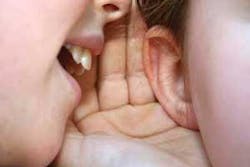Compliance Issues
Learn to listen
by Diane Chandler, RDH
Have you ever caught yourself hearing what's being said but not really listening? Hearing implies a passive act, while listening requires a different level of concentration. For example, when you hear a song you have to listen carefully to learn the words. This may take several repetitions before you can finally sing along with the music.
Understanding this hearing/listening concept might apply to patients who resist making changes in their daily dental hygiene regimen. As a dental hygienist, the challenge is to motivate patients to comply with suggestions that can lead to better oral hygiene. There are always patients who refuse to brush, floss, or rinse, particularly before bedtime. These same patients can probably recite all the excuses in the book for not doing these tasks. Your role as a hygienist is to always support the care needed to keep the mouth healthy. Repeating these procedures every visit may help because repetition promotes learning.
Patients who may hear you but are not listening to you are those who do not internalize the consequences of not following the prescribed regimen. Perhaps focusing on the benefits can bring a positive spin to the discussion. When patients “have” to do this or that, they may feel trapped and stop listening. If the benefits were emphasized, such as whiter teeth, less plaque, fewer cavities, and fresher breath, patients may listen more intently.
Another strategy is sitting down with a patient after a procedure and making a personal appeal by making eye-to-eye contact. If a patient is looking at the ceiling in the reclined position while work is being done, his or her mind may very well be in a different place.
With this one-on-one time you can have the patient demonstrate his or her understanding of a task, such as flossing. This works particularly well with children. The assumption that everyone knows how to floss is not correct.
The taste of the product, especially for rinsing, is another reason for not complying with this task. So finding the right product is essential for compliance. The number of dental aids on the market provide many options. Patients need to be directed toward the products that specifically address any issues they're having. Keep in mind that it can be costly to speculate, but if samples are available through your office, those can minimize the cost factor. Also, some manufacturers offer trial sizes so that patients need not invest in the “bargain” super size. This tactic can also be applied to toothpaste. Finding the right mix can be painstaking.
Developing a routine to perform these procedures can be a huge stumbling block to compliance. The most logical times are bedtime and just after waking up. After each meal is ideal, but these times are generally not convenient. Remember that practice makes perfect and sometimes leads to efficiency. Some procedures are transportable and can be done during the workday. However, procedures that depend on appliances or a water source may best be done at home. Another efficiency suggestion is to have a kit with portable dental aids. These can easily be placed in the pocket, glove compartment, backpack, cosmetic bag, and every bathroom in the house. Keeping the supply handy is a convenient first step.
While the focus is on the patient's ability to listen, the dental hygienist also needs to take responsibility for listening. When a patient continuously disregards the products and procedures for healthier teeth and gums, the hygienist should look for other ways to assess the issues. Giving up is not an option. A method of last resort is bribery. While unconventional at best, it sometimes works. Fewer visits, less painful cleanings, and better plaque scores can be incentives to improve compliance.
Ultimately, the hygienist should not feel totally responsible for noncompliant behavior. Keep your attitude positive and your criticism to a minimum. Be vigilant about doing your job. Be the person who cares.
About the author
Diane Chandler, RDH, CDA, has worked for over 25 years in the dental field as a hygienist, college instructor, and office manager. She has relied on this multi-faceted experience to author numerous published articles on a wide range of clinical, educational, and business management topics.

